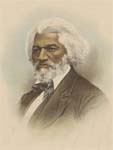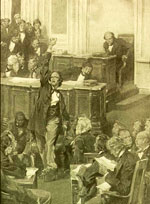That Frederick Douglass was an abolitionist is beyond debate. Born a slave, he eventually escaped and became one of the most famous activists to work for emancipation. Whether working as a stump speaker or editing one abolitionist newspaper after another, Douglass expressed tremendous hope that the slave power would eventually fall. He once declared, “There is not a man beneath the canopy of heaven, that does not know that slavery is wrong for him.” That Douglass was radical in his anti-slavery speeches and newspaper editorials is somewhat debatable, and would depend on how one defines “radical.”
“Hereditary bondmen! Know ye not / Who would be free, themselves must strike the blow?”
Frederick Douglass was fond of quoting this line from Lord Byron as it summed up his political activism. This call to the enslaved to be their own liberators reflected a revolutionary urgency and fervor most would associate with radical measures. But compared with abolitionists like William Lloyd Garrison, Douglass’s one-time mentor and fiery editor of the Liberator (whose masthead read “No Union with Slaveholders”), Frederick Douglass appears measured and sensible. For example, Douglass once wrote, “My position now is one of reform, not revolution. I would act for the abolition of slavery through the government—not over its ruins.”
In contrast, Garrison burned a copy of the Constitution in public, calling it “the most bloody and heaven-daring arrangement ever made by men for the continuance and protection of a system of the most atrocious villainy [sic] ever exhibited on earth.” Most famously, he pronounced the Constitution “a covenant with death,” “an agreement with hell,” and “refuge of lies.”
"Mr. Garrison and his friends tell us that while in the Union we are responsible for slavery. . .
Even more extreme was John Brown, who tried to recruit Douglass for a raid on the federal armory in Harpers Ferry, VA, a doomed venture that exacerbated sectional tensions leading up to the 1860 presidential election. Brown believed the seizure of the armory would spur local slaves to rise up against their masters and spark a slave rebellion throughout the South. Douglass shunned the effort. As historian David Blight observed, “For Douglass, the question of violence was always more a tactical than a moral problem. He did not relish the prospect, but morally he believed the slaves had the right to rise up and slay their masters.” Compared with the lawlessness of Garrison and Brown and their disrespect for the Constitution, Douglass’s abolitionism looks less radical, if not tame.
. . . I admit our responsibility for slavery while in the Union, but I deny that going out of the Union would free us from that responsibility. . .
Douglass sought to free the slaves within the confines of the Constitution. He thought only by keeping the slave states within the American Union could the federal government then be used to rid the nation of slavery. Douglass came to view the Constitution as a pro-liberty document, thus agreeing with Lincoln “the Great Emancipator” on the principal means of promoting freedom.
Lincoln understood the Founders to expect slavery to wither away in a generation or two by restricting its importation into the new nation (as early as 1808) and preventing its expansion into federal territory (see, the Northwest Ordinance of 1787). As historian James Oakes writes: “Abraham Lincoln and Frederick Douglass agreed that there was no such thing as a constitutional right to own slaves. But for Lincoln the Constitution recognized the existence of slavery as a practical necessity, whereas for Douglass the absence of a right to own slaves obliged the federal government to overthrow slavery everywhere.”
. . .The American people in the Northern States have helped to enslave the black people. Their duty will not have been done till they give them back their plundered rights." — Frederick Douglass
In sum, what made Frederick Douglass an abolitionist was his experience with slavery firsthand: simply stated, he found it a poor fit for his humanity. He became a radical abolitionist, calling for the immediate abolition of slavery, because he came to view the U.S. Constitution as a pro-liberty document that could be interpreted to permit Congress to abolish slavery not only from federal territories but also in the states where it already existed. One might say his aims were radical, while his means, especially after the break from Garrison, were not radical insofar as they remained within the American constitutional context.

